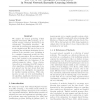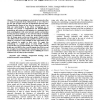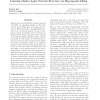483 search results - page 17 / 97 » Learning Relational Sum-Product Networks |
103
Voted
ICML
2003
IEEE
16 years 1 months ago
2003
IEEE
We analyze the formal grounding behind Negative Correlation (NC) Learning, an ensemble learning technique developed in the evolutionary computation literature. We show that by rem...
103
click to vote
ICC
2007
IEEE
15 years 6 months ago
2007
IEEE
— To enhance the generalization capacity of a distribution learning method, we propose to use a fuzzy Bayesian framework based on Bayes rules. The precision of the learning resul...
140
Voted
SOCIALCOM
2010
14 years 10 months ago
2010
Text data pertaining to socio-technical networks often are analyzed separately from relational data, or are reduced to the fact and strength of the flow of information between node...
92
Voted
ICALT
2008
IEEE
15 years 7 months ago
2008
IEEE
Ad-hoc sensor networks provide a cheap and scalable technology for constructing pervasive learning assessment systems that are embedded in physical environments. This paper propos...
96
Voted
ICML
2009
IEEE
16 years 1 months ago
2009
IEEE
Markov logic networks (MLNs) combine logic and probability by attaching weights to first-order clauses, and viewing these as templates for features of Markov networks. Learning ML...



